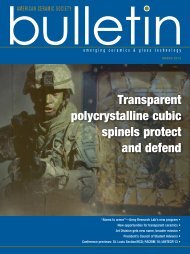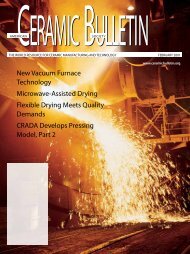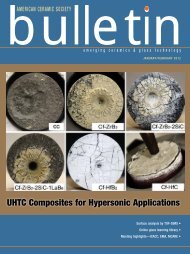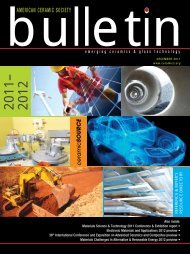American Ceramic Society Bulletin
American Ceramic Society Bulletin
American Ceramic Society Bulletin
Create successful ePaper yourself
Turn your PDF publications into a flip-book with our unique Google optimized e-Paper software.
‘Cotton candy’ that heals?<br />
Steve Jung, left, and Mo-Sci CEO and president Ted Day. Jung’s research contributed to<br />
the development of the DermaFuse material, and he now works for Mo-Sci.<br />
without being directed, so I asked him<br />
to talk to some of the doctors and talk<br />
to the hospital board and see if they<br />
were interested. I suggested to him that<br />
if one of the doctors was interested,<br />
they should ask for me to assist them<br />
with it. Then I could be involved.”<br />
Ted Day did formally contact<br />
PCRMC officials and the institution’s<br />
Internal Review Board. He showed<br />
them samples of the DermaFuse and<br />
presented the data on the biocompatibility<br />
and excellent quality of regenerated<br />
tissue in the rat model. Day says<br />
the IRB ultimately approved a smallscale<br />
human trial to treat nonhealing<br />
venous stasis ulcers in diabetic patients.<br />
“The IRB agreed to selected possible<br />
participants based on protocol they<br />
established,” Day says. “Their criteria<br />
essentially narrowed in on patients<br />
whose wound status made them likely<br />
candidates for amputation down the<br />
road. Each participant had to have<br />
at least one nonhealing venous stasis<br />
ulcer, and that wound had to have been<br />
treated with conventional dressings<br />
with no improvement for a minimum<br />
of two weeks prior to enrolling. The<br />
treatments – applying a pad of the<br />
DermaFuse one or two times per week –<br />
were to be done only by PCRMC staff<br />
supervised by doctors until the wounds<br />
resolved.<br />
Dr. William Stoecker, a dermatologist<br />
who practices at PCRMC, agreed<br />
to do most of the supervisory work for<br />
the IRB. And, Ted Day suggested to<br />
Stoecker that Taylor might be interested<br />
in helping.<br />
“So, Dr. Stoecker did ask for my<br />
assistance,” says Taylor. “Both of us had<br />
our doubts, but we have a pretty openminded<br />
culture and we use a lot of cutting-edge<br />
technology for a hospital of<br />
our size. But we also got really curious<br />
about how the bioactive glass material<br />
might work.”<br />
The IRB granted approval for the<br />
treatments in July 2010, and Stoecker<br />
and Taylor got their first patient – the<br />
one mentioned at the top of this story –<br />
a month later.<br />
“We started with one patient,”<br />
recounts Taylor. She was our only<br />
patient for several weeks. Number two<br />
was a patient who soon dropped out of<br />
the study. Then came number three,<br />
four, five and six.”<br />
Taylor confesses that her first patient<br />
helped a lot with recruiting other<br />
volunteers for the trial. The smalltown<br />
atmosphere in Rolla also helped.<br />
“With her nursing background, our first<br />
patient had been exposed to medical<br />
research before. She and her husband<br />
were very eager to see things like this<br />
new study happen. Her husband is a<br />
golfer and country-clubber and she is<br />
a bridge-club lady, and they talked it<br />
up among their friends and at their<br />
church. Because of them, pretty soon<br />
we had a lot of hubbub about this in<br />
the community and more people inquiring<br />
about the study. It also helped that<br />
a lot of people know the Days in this<br />
area,” says Taylor.<br />
The nitty gritty of<br />
using ‘DermaFuse’<br />
Wound care is not for the squeamish.<br />
Taylor eventually began treating 12<br />
patients as part of the study, and the<br />
wounds she saw ranged from around<br />
1 centimeter by 1 centimeter with a<br />
depth of 0.1 centimeter (about the size<br />
of a small fingernail) to much larger<br />
ones. “We have three or four in our<br />
study where I could see bone, tendon,<br />
vessels and nerve strands covered by<br />
a thin layer of debris. That’s because<br />
these wounds have gone on and on for<br />
so long,” she says.<br />
The DermaFuse glass material arrives<br />
for use sterilized and in a flat foil packet.<br />
Taylor starts by physically removing<br />
unwanted debris (debriding) and flushing<br />
the area. She needs to begin with a<br />
clean, moist wound bed. Often an antimicrobial<br />
solution is applied.<br />
Then its time for the glass. Taylor<br />
describes her method saying, “Because<br />
it comes to me in a flat pack, it gets<br />
kind of squished, but it looks just like<br />
cotton candy. You can form it, you can<br />
pick it, you can make any kind of shape<br />
you need out of it. Sometimes I apply<br />
the material with tweezers. Sometimes I<br />
put it on my gloved hand.”<br />
If the wound has a cavity or tunneling,<br />
it gets a little trickier. “I will use<br />
tweezers to pack the material up into all<br />
of the recesses before filling the rest of<br />
the wound. I don’t pack it hard, but just<br />
a little to get it into all of the crevices,”<br />
she says.<br />
Once the wound is covered in the<br />
material, she applies a secondary covering<br />
to hold the DermaFuse in place.<br />
This is often followed by some type of<br />
compression wrap. The patients then<br />
can go for two or three days before they<br />
need to be seen by Taylor again.<br />
Daily dressing changes can be more<br />
detrimental than helpful. She says,<br />
“You risk disturbing that fragile tissue<br />
in the wound bed too often and not<br />
giving a chance to mature into healing<br />
28 <strong>American</strong> <strong>Ceramic</strong> <strong>Society</strong> <strong>Bulletin</strong>, Vol. 90, No. 4<br />
(Credit: The <strong>American</strong> <strong>Ceramic</strong> <strong>Society</strong>)






